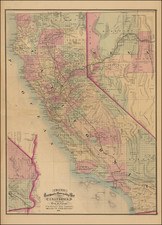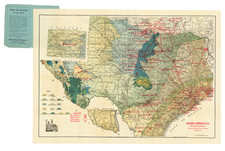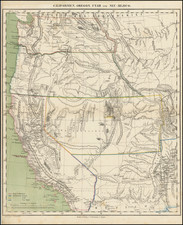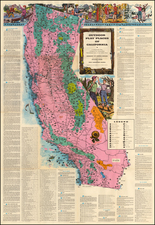Rare Texas Emigrant Map
Extremely rare map of Texas, Mexico and contiguous regions, which appeared in volume 6 of Freidrich Heinzelmann's Die Weltkunde in einer planmassig geordneten rundscahu der wichtiigsten neueren Land-und Seereifen für das jünglingsalter und die gebildeteren aller stände . . . published by Dr. Wilhelm Harnisch in Leipzig in 1851.
The map was published to illustrate an article entitled Reisebilder und Skizzen aus der pyrenäischen Halbinsel, nebst Blicken auf Tejas, Neu-Mejico und Californien. which begins at page 551.
Includes an inset map entitled: Karte von Hafen San Francisco und dem Golddistrict am Sacramento, which is listed as Wheat, Mapping of the Gold Regions, #194.
The map provides a nice treatment of the River Systems, Indian tribes and early settlements in Texas, including Parker's Fort (established in 1384 by Baptist Preacher John Parker), Torrey's Trading House (an important trading house for German Emigrants, as noted below), Ft. Towson, the Chihuahua Trail and a few other relatively unique details. To the north, the route of Josiah Gregg in 1839 and 1840 is shown, along with the route from Wagon Road from Independence to Santa Fe.
Fort Parker was the site of massacre of Texas settlers in May 1836 in which members of the pioneer Parker family were killed in a raid by Native Americans. In this raid, a 9-year old girl, Cynthia Ann Parker, was captured and spent most of the rest of her life with the Comanche, marrying a Chief, Peta Nocona, and giving birth to a son, Quanah Parker, who would become the last Chief of the Comanches. Her brother, John Richard Parker, who was also captured, was ransomed back after six years, but unable to adapt to white society, ran back to the Comanches.
Torrey's Trading House
As noted by the Handbook of Texas on-line:
The firm of Torrey and Brothers traded widely with the Indians for about ten years, from John F. Torrey's arrival in Houston in 1838 until 1848, when the Torreys sold the major trading house to George Barnard. . . . The Torreys conducted a significant fur trade, assisted in the establishment of New Braunfels, recovered stolen horses and captives from the Indians, and established what was perhaps the first regional bank in the United States. John Torrey and his brothers David K. and Thomas S. Torrey built the first frame house in Houston and used it as a trading post and as a supply center for their other posts. David purchased goods in Boston and New York. . . .
The Torreys operated a trading house on the Bosque River in 1842 and established houses at Austin, San Antonio (1844), New Braunfels (1845), and Fredericksburg. Barnard opened a branch store on the Navasota River in 1843, and, at Houston's request, the firm opened a branch at the falls of the Brazos. The Brazos post, on Tehuacana Creek in McLennan County, received a license in December 1843 after the Torreys made bond for $10,000. With its official status under a law of the Republic of Texas passed in 1843, the post had a near monopoly of the Texas Indian trade.
In 1846 Dr. Ferdinand von Roemer made a trip from New Braunfels to the Brazos post with John Torrey and described the trading house as standing in a post oak grove on a high, pebble-covered hill overlooking Tehuacana Creek. The post comprised six or seven houses built of rough-hewn logs. The largest house held pelts, another contained trade goods for the Indians, and the remaining served as living quarters. In 1846 Paul Richardson built an additional building for a fee of $100. The post traded goods to the Indians and, for a price, recovered stolen horses, runaway slaves, and captured Mexicans from the Indians. Indians frequently met at a council ground some four miles west of the trading post. In May 1845 about 1,000 lodges, or 4,000 persons, camped near the post. On November 16, 1845, Thomas I. Smith and George W. Terrell made a treaty with the Kichai, Tawakoni, Waco, and Wichita groups at the post.
In 1844 the Torrey brothers furnished Prince Carl of Solms-Braunfels with weapons for the Adelsverein. The brothers contracted with John O. Meusebach to provision and transport German immigrants from the coast inland.
Rarity
The map is quite rare on the market. This is only the second example we have seen in 25 years.









![[Matagorda Bay] Bahia De S. Bernardo](https://storage.googleapis.com/raremaps/img/small/58540.jpg)

![[ Republic of Texas - Rare Early Variant ] Texas Compiled from the latest and best Authorities.](https://storage.googleapis.com/raremaps/img/small/96842.jpg)


